Socioeconomic Factors Influence the Spatial and Temporal Distribution of Blue–Green Infrastructure Demand: A Case of Nanjing City
Abstract
:1. Introduction
2. Materials and Methods
2.1. Study Area Overview
2.2. Demand Evaluation Indicators
2.2.1. Source and Processing of Indicator Data
- (1)
- Population density
- (2)
- Building density
- (3)
- Night light
- (4)
- Intensity of land development
- (5)
- Carbon emissions
- (6)
- Fragmentation
- (7)
- Surface temperature
- (8)
- PM2.5
2.2.2. Weight Determination
2.3. Influencing Factors of Blue–Green Infrastructure Demand
3. Results
3.1. Changes in the Spatial and Temporal Pattern of Demand
3.1.1. Social Demand
3.1.2. Economic Demand
3.1.3. Ecological Demand
3.1.4. Environmental Demand
3.1.5. Overall Demand
3.2. Influencing Factors of Blue–Green Infrastructure Demand
3.2.1. Level of Economic Development
3.2.2. Urban Spatial Pattern
3.2.3. Decision Management Orientation
4. Discussion
4.1. Comprehensive Blue–Green Infrastructure Demand Evaluation System
4.2. Layout of Blue–Green Infrastructure Demand for Mega Cities
4.3. Influencing Factors of Blue–Green Infrastructure Demand
5. Conclusions
Author Contributions
Funding
Institutional Review Board Statement
Informed Consent Statement
Data Availability Statement
Conflicts of Interest
References
- Matthews, T.; Lo, A.Y.; Byrne, J.A. Reconceptualizing green infrastructure for climate change adaptation: Barriers to adoption and drivers for uptake by spatial planners. Landsc. Urban Plan. 2015, 138, 155–163. [Google Scholar] [CrossRef]
- Monteiro, R.; Ferreira, J.C.; Antunes, P. Green Infrastructure Planning Principles: An Integrated Literature Review. Land 2021, 9, 525. [Google Scholar] [CrossRef]
- Wagner, I. Formally designate blue-green infrastructure for climate adaptation. Nature 2022, 607, 657. [Google Scholar] [CrossRef] [PubMed]
- Grimm, N.B.; Faeth, S.H.; Golubiewski, N.E.; Redman, C.L.; Wu, J.G.; Bai, X.M.; Briggs, J.M. Global change and the ecology of cities. Science 2008, 319, 756–760. [Google Scholar] [CrossRef] [PubMed] [Green Version]
- Wu, J.G. Urban ecology and sustainability: The state-of-the-science and future directions. Landsc. Urban Plan. 2014, 125, 209–221. [Google Scholar] [CrossRef]
- Dorst, H.; van der Jagt, A.; Raven, R.; Runhaar, H. Urban greening through nature-based solutions-Key characteristics of an emerging concept. Sustain. Cities Soc. 2019, 49, 101620. [Google Scholar] [CrossRef]
- Toxopeus, H.; Polzin, F. Reviewing financing barriers and strategies for urban nature-based solutions. J. Environ. Manag. 2021, 289, 112371. [Google Scholar] [CrossRef]
- Hansen, R.; Pauleit, S. From Multifunctionality to Multiple Ecosystem Services? A Conceptual Framework for Multifunctionality in Green Infrastructure Planning for Urban Areas. Ambio 2014, 43, 516–529. [Google Scholar] [CrossRef] [Green Version]
- Conway, T.M.; Khan, A.; Esak, N. An analysis of green infrastructure in municipal policy: Divergent meaning and terminology in the Greater Toronto Area. Land Use Policy 2020, 99, 104864. [Google Scholar] [CrossRef]
- Garcia, A.M.; Sante, I.; Loureiro, X.; Miranda, D. Spatial Planning of Green Infrastructure for Mitigation and Adaptation to Climate Change at a Regional Scale. Sustainability 2020, 12, 10525. [Google Scholar] [CrossRef]
- Mertens, E.; Stiles, R.; Karadeniz, N. Green May Be Nice, but Infrastructure Is Necessary. Land 2022, 11, 89. [Google Scholar] [CrossRef]
- Chen, X.F.; Xu, L.H.; Zhu, R.S.; Ma, Q.W.; Shi, Y.J.; Lu, Z.W. Changes and Characteristics of Green Infrastructure Network Based on Spatio-Temporal Priority. Land 2022, 11, 901. [Google Scholar] [CrossRef]
- Dou, Y. Assessing the importance of cultural ecosystem services in urban areas of Beijing municipality. Ecosyst. Serv. 2017, 44, 79–90. [Google Scholar] [CrossRef]
- Langemeyer, J.; Wedgwood, D.; McPhearson, T.; Baro, F.; Madsen, A.L.; Barton, D.N. Creating urban green infrastructure where it is needed—A spatial ecosystem service-based decision analysis of green roofs in Barcelona. Sci. Total Environ. 2020, 707, 135487. [Google Scholar] [CrossRef]
- Dai, X.; Wang, L.C.; Tao, M.H.; Huang, C.B.; Sun, J.; Wang, S.Q. Assessing the ecological balance between supply and demand of blue-green infrastructure. J. Environ. Manag. 2021, 288, 112454. [Google Scholar] [CrossRef] [PubMed]
- Zhang, F.; Wang, X.T.; Liu, X.J. Research on Functional Value Estimation and Development Mode of Green Infrastructure Based on Multi-Dimensional Evaluation Model: A Case Study of China. Land 2022, 11, 1603. [Google Scholar] [CrossRef]
- Wang, D.M.; Liu, C.; Guo, Y.; Tang, P.X.; Jiao, J.; Kong, W.H.; Zhang, L.; Liu, Y.P.; Kong, D.Z. Research strategy for constructing a green infrastructure network based on spatial prioritization. Ecosyst. Health Sustain. 2022, 8, 2088403. [Google Scholar] [CrossRef]
- Wang, D.M.; Hu, Y.G.; Tang, P.X.; Liu, C.; Kong, W.H.; Jiao, J.; Kovacs, K.F.; Kong, D.Z.; Lei, Y.K.; Liu, Y.P. Identification of Priority Implementation Areas and Configuration Types for Green Infrastructure Based on Ecosystem Service Demands in Metropolitan City. Int. J. Environ. Res. Public Health 2022, 19, 8191. [Google Scholar] [CrossRef]
- Tanaka, K.; Nelson, H.; McCullar, N.; Parulekar, N. Citizens’ preferences on green infrastructure practices and their enhancement in Portland, Oregon. J. Environ. Manag. 2022, 318, 115415. [Google Scholar] [CrossRef] [PubMed]
- Wolff, S.; Schulp, C.J.E.; Verburg, P.H. Mapping ecosystem services demand: A review of current research and future perspectives. Ecol. Indic. 2015, 55, 159–171. [Google Scholar] [CrossRef]
- Rupprecht, C.D.D. Informal Urban Green Space: Residents’ Perception, Use, and Management Preferences across Four Major Japanese Shrinking Cities. Land 2017, 6, 59. [Google Scholar] [CrossRef] [Green Version]
- Manes, F.; Marando, F.; Capotorti, G.; Blasi, C.; Salvatori, E.; Fusaro, L.; Ciancarella, L.; Mircea, M.; Marchetti, M.; Chirici, G.; et al. Regulating Ecosystem Services of forests in ten Italian Metropolitan Cities: Air quality improvement by PM10 and O3 removal. Ecol. Indic. 2016, 67, 425–440. [Google Scholar] [CrossRef]
- Fisher, B.; Turner, R.K.; Morling, P. Defining and Classifying Ecosystem Services for Decision Making. Ecol. Econ. 2009, 68, 643–653. [Google Scholar] [CrossRef] [Green Version]
- Tiwari, A.; Kumar, P.; Kalaiarasan, G.; Ottosen, T.B. The impacts of existing and hypothetical green infrastructure scenarios on urban heat island formation. Environ. Pollut. 2021, 274, 115898. [Google Scholar] [CrossRef]
- Liquete, C.; Kleeschulte, S.; Dige, G.; Maes, J.; Grizzetti, B.; Olah, B.; Zulian, G. Mapping green infrastructure based on ecosystem services and ecological networks: A Pan-European case study. Environ. Sci. Policy 2015, 54, 268–280. [Google Scholar] [CrossRef]
- Choumert, J. An empirical investigation of public choices for green spaces. Land Use Policy 2010, 27, 1123–1131. [Google Scholar] [CrossRef] [Green Version]
- Abass, K.; Appiah, D.O.; Afriyie, K. Does green space matter? Public knowledge and attitude towards urban greenery in Ghana. Urban For. Urban Green. 2019, 46, 126462. [Google Scholar] [CrossRef]
- Baker, F.; Smith, G.R.; Marsden, S.J.; Cavan, G. Mapping regulating ecosystem service deprivation in urban areas: A transferable high-spatial resolution uncertainty aware approach. Ecol. Indic. 2021, 121, 107058. [Google Scholar] [CrossRef]
- Schipperijn, J.; Stigsdotter, U.K.; Randrup, T.B.; Troelsen, J. Influences on the use of urban green space—A case study in Odense, Denmark. Urban For. Urban Green. 2010, 9, 25–32. [Google Scholar] [CrossRef]
- Winker, M.; Deffner, J.; Rohrbach, M.; Schramm, E.; Stein, M. Enhancing blue-green infrastructure in German cities with the involvement of urban society: Insights from Frankfurt/Main and Stuttgart. Blue-Green Syst. 2022, 4, 230–246. [Google Scholar] [CrossRef]
- Baptiste, A.K.; Foley, C.; Smardon, R. Understanding urban neighborhood differences in willingness to implement green infrastructure measures: A case study of Syracuse, NY. Landsc. Urban Plan. 2015, 136, 1–12. [Google Scholar] [CrossRef]
- Liu, W.P.; Holst, J.; Yu, Z.R. Thresholds of landscape change: A new tool to manage green infrastructure and social-economic development. Landsc. Ecol. 2014, 29, 729–743. [Google Scholar] [CrossRef]
- Ma, T.; Zhou, Y.K.; Zhou, C.H.; Haynie, S.; Pei, T.; Xu, T. Night-time light derived estimation of spatio-temporal characteristics of urbanization dynamics using DMSP/OLS satellite data. Remote Sens. Environ. 2015, 158, 453–464. [Google Scholar] [CrossRef]
- Alahmadi, M.; Atkinson, P.M. Three-Fold Urban Expansion in Saudi Arabia from 1992 to 2013 Observed Using Calibrated DMSP-OLS Night-Time Lights Imagery. Remote Sens. 2019, 11, 2266. [Google Scholar] [CrossRef] [Green Version]
- Chen, W.Y. The role of urban green infrastructure in offsetting carbon emissions in 35 major Chinese cities: A nationwide estimate. Cities 2015, 44, 112–120. [Google Scholar] [CrossRef]
- Donati, G.F.A.; Bolliger, J.; Psomas, A.; Maurer, M.; Bach, P.M. Reconciling cities with nature: Identifying local Blue-Green Infrastructure interventions for regional biodiversity enhancement. J. Environ. Manag. 2022, 316, 115254. [Google Scholar] [CrossRef] [PubMed]
- He, N.P.; Wen, D.; Zhu, J.X.; Tang, X.L.; Xu, L.; Zhang, L.; Hu, H.F.; Huang, M.; Yu, G.R. Vegetation carbon sequestration in Chinese forests from 2010 to 2050. Glob. Change Biol. 2017, 23, 1575–1584. [Google Scholar] [CrossRef]
- Carlier, J.; Moran, J. Landscape typology and ecological connectivity assessment to inform Greenway design. Sci. Total Environ. 2019, 651, 3241–3252. [Google Scholar] [CrossRef]
- Rafal, B.; Hanna, H.G.; Alicja, H.N. Green infrastructure-countering ecosystem fragmentation: Case study of a municipality in the Carpathian Foothills. Forests 2021, 12, 78. [Google Scholar] [CrossRef]
- Tian, P.; Li, J.L.; Cao, L.D.; Pu, R.L.; Wang, Z.Y.; Zhang, H.T.; Chen, H.L.; Gong, H.B. Assessing spatiotemporal characteristics of urban heat islands from the perspective of an urban expansion and green infrastructure. Sustain. Cities Soc. 2021, 74, 103208. [Google Scholar] [CrossRef]
- Li, W.; Sun, B.D.; Zhao, J.C.; Zhang, T.L. Economic performance of spatial structure in Chinese prefecture regions: Evidence from night-time satellite imagery. Habitat Int. 2018, 76, 29–39. [Google Scholar] [CrossRef]
- Cheon, S.; Kim, J.A. Quantifying the influence of urban sources on night light emissions. Landsc. Urban Plan. 2020, 204, 103936. [Google Scholar] [CrossRef]
- Hu, C.Z.; Huang, X.J.; Zhong, T.Y.; Tan, D. Character of Carbon Emission in China and Its Dynamic Development Analysis. China Popul. Resour. Environ. 2008, 18, 38–42. (In Chinese) [Google Scholar]
- Menard, S. Six approaches to calculating standardized logistic regression coefficients. Am. Stat. 2004, 58, 218–223. [Google Scholar] [CrossRef]
- Zheng, W.; Barker, A. Green infrastructure and urbanisation in suburban Beijing: An improved neighbourhood assessment framework. Habitat Int. 2021, 117, 102423. [Google Scholar] [CrossRef]
- Basnou, C.; Baro, F.; Langemeyer, J.; Castell, C.; Dalmases, C.; Pino, J. Advancing the green infrastructure approach in the Province of Barcelona: Integrating biodiversity, ecosystem functions and services into landscape planning. Urban For. Urban Green. 2020, 55, 126797. [Google Scholar] [CrossRef]
- Zardo, L.; Geneletti, D.; Perez-Soba, M.; Van Eupen, M. Estimating the cooling capacity of green infrastructures to support urban planning. Ecosyst. Serv. 2017, 26, 225–235. [Google Scholar] [CrossRef]
- Reining, C.E.; Lemieux, C.J.; Doherty, S.T. Linking restorative human health outcomes to protected area ecosystem diversity and integrity. J. Environ. Plan. Manag. 2021, 64, 2300–2325. [Google Scholar] [CrossRef]
- Li, F.; Liu, X.S.; Zhang, X.L.; Zhao, D.; Liu, H.X.; Zhou, C.B.; Wang, R.S. Urban ecological infrastructure: An integrated network for ecosystem services and sustainable urban systems. J. Clean. Prod. 2017, 163, S12–S18. [Google Scholar] [CrossRef]
- Barbati, A.; Corona, P.; Salvati, L.; Gasparella, L. Natural forest expansion into suburban countryside: Gained ground for a green infrastructure? Urban For. Urban Green. 2013, 12, 36–43. [Google Scholar] [CrossRef] [Green Version]
- Xu, H.Y.; Zhao, G.H. Assessing the Value of Urban Green Infrastructure Ecosystem Services for High-Density Urban Management and Development: Case from the Capital Core Area of Beijing, China. Sustainability 2021, 13, 12115. [Google Scholar] [CrossRef]
- Shi, L.F.; Wurm, M.; Huang, X.J.; Zhong, T.Y.; Taubenbock, H. Measuring the spatial hierarchical urban system in China in reference to the Central Place Theory. Habitat Int. 2020, 105, 102264. [Google Scholar] [CrossRef]
- Gu, X.K.; Li, Q.; Chand, S. Factors influencing residents’ access to and use of country parks in Shanghai, China. Cities 2020, 97, 102501. [Google Scholar] [CrossRef]
- Toxopeus, H.; Kotsila, P.; Conde, M.; Katona, A.; van der Jagt, A.P.N.; Polzin, F. How ‘just’ is hybrid governance of urban nature-based solutions? Cities 2020, 105, 102839. [Google Scholar] [CrossRef]
- Bernal, C.L.R.; Durosaiye, I.O.; Hadjri, K.; Corredor, S.K.Z.; Duran, E.S.; Prieto, A.C. Neglected landscapes and green infrastructure: The case of the Limas Creek in Bogotá, Colombia. Geoforum 2022, 136, 194–210. [Google Scholar] [CrossRef]
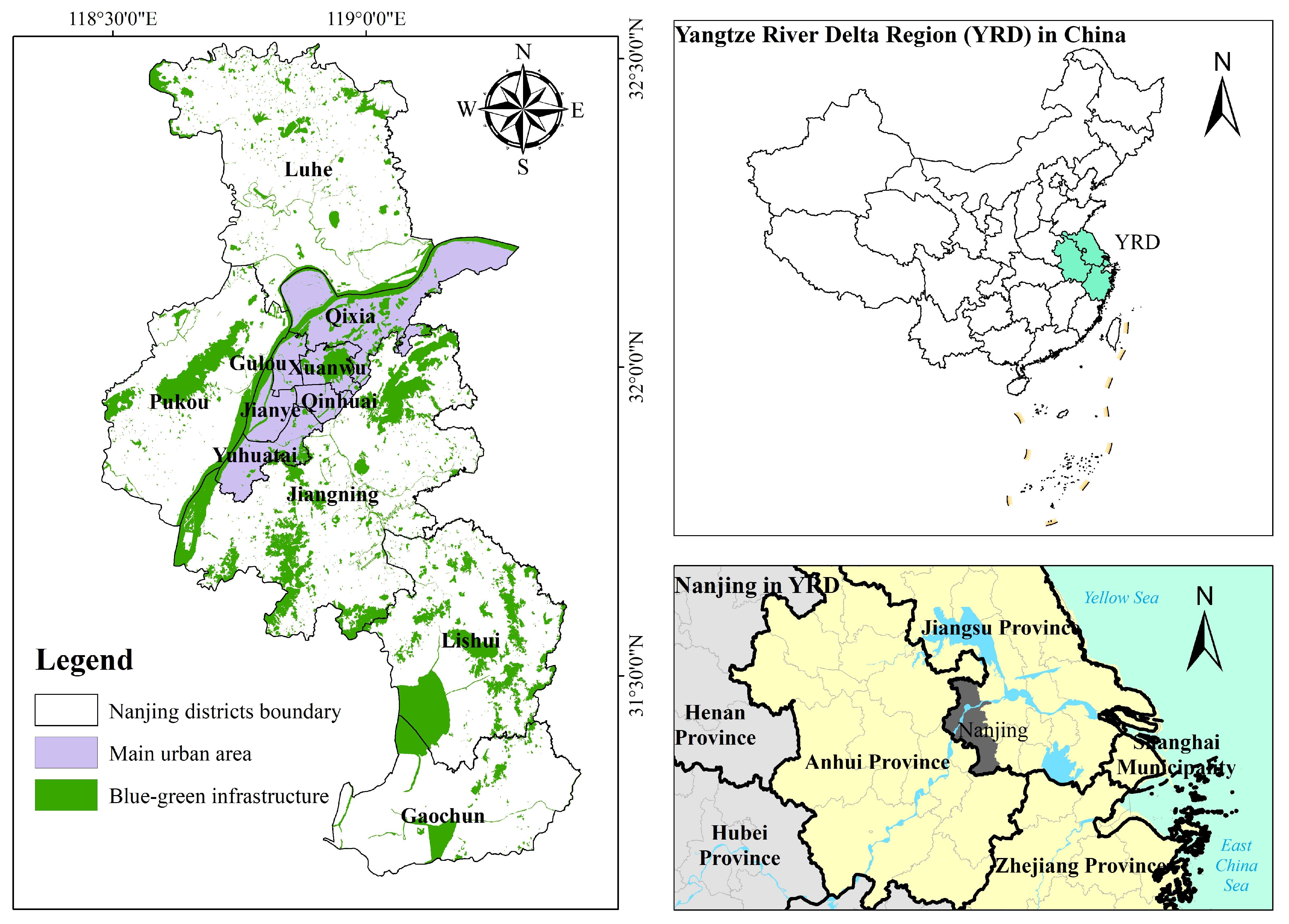
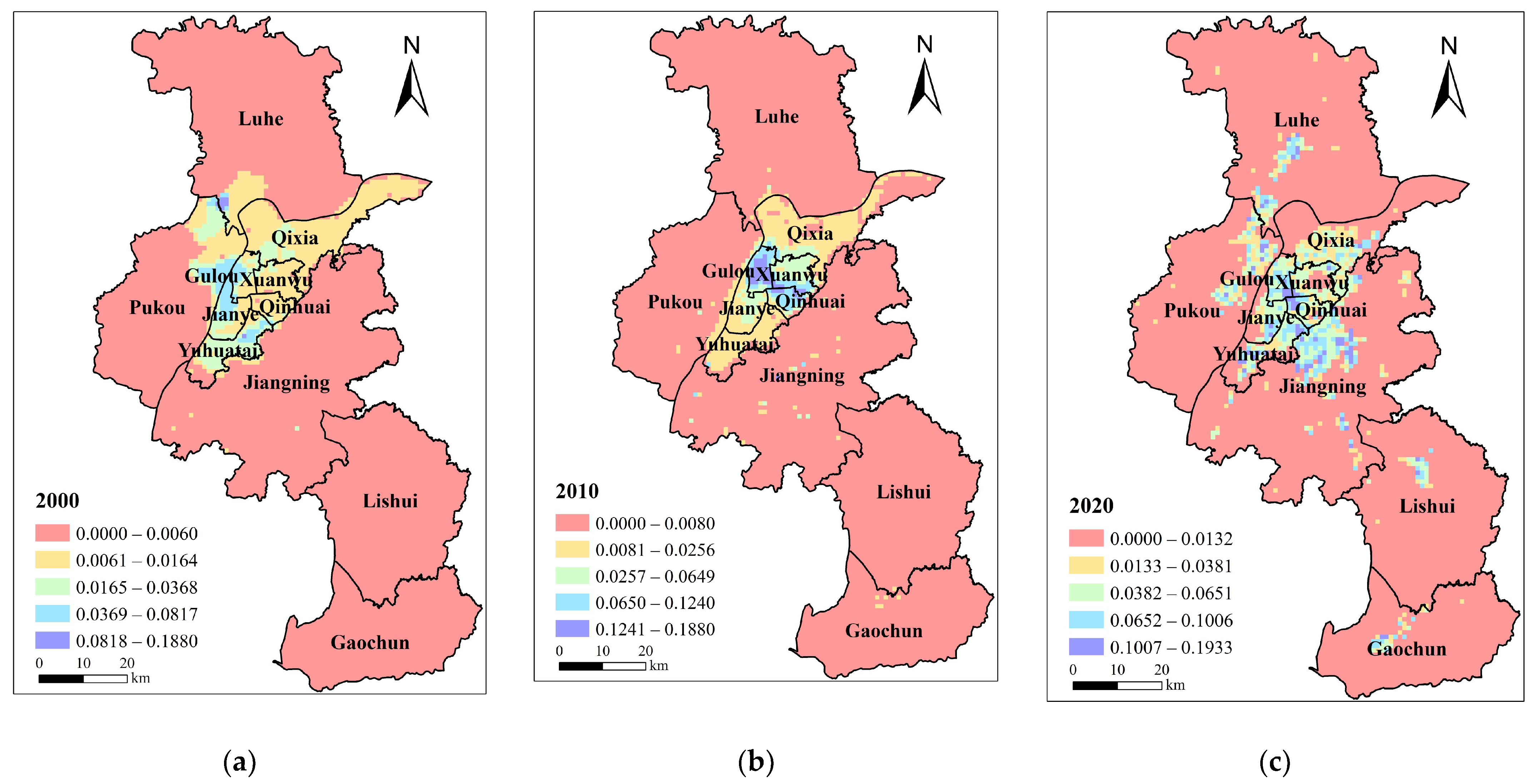
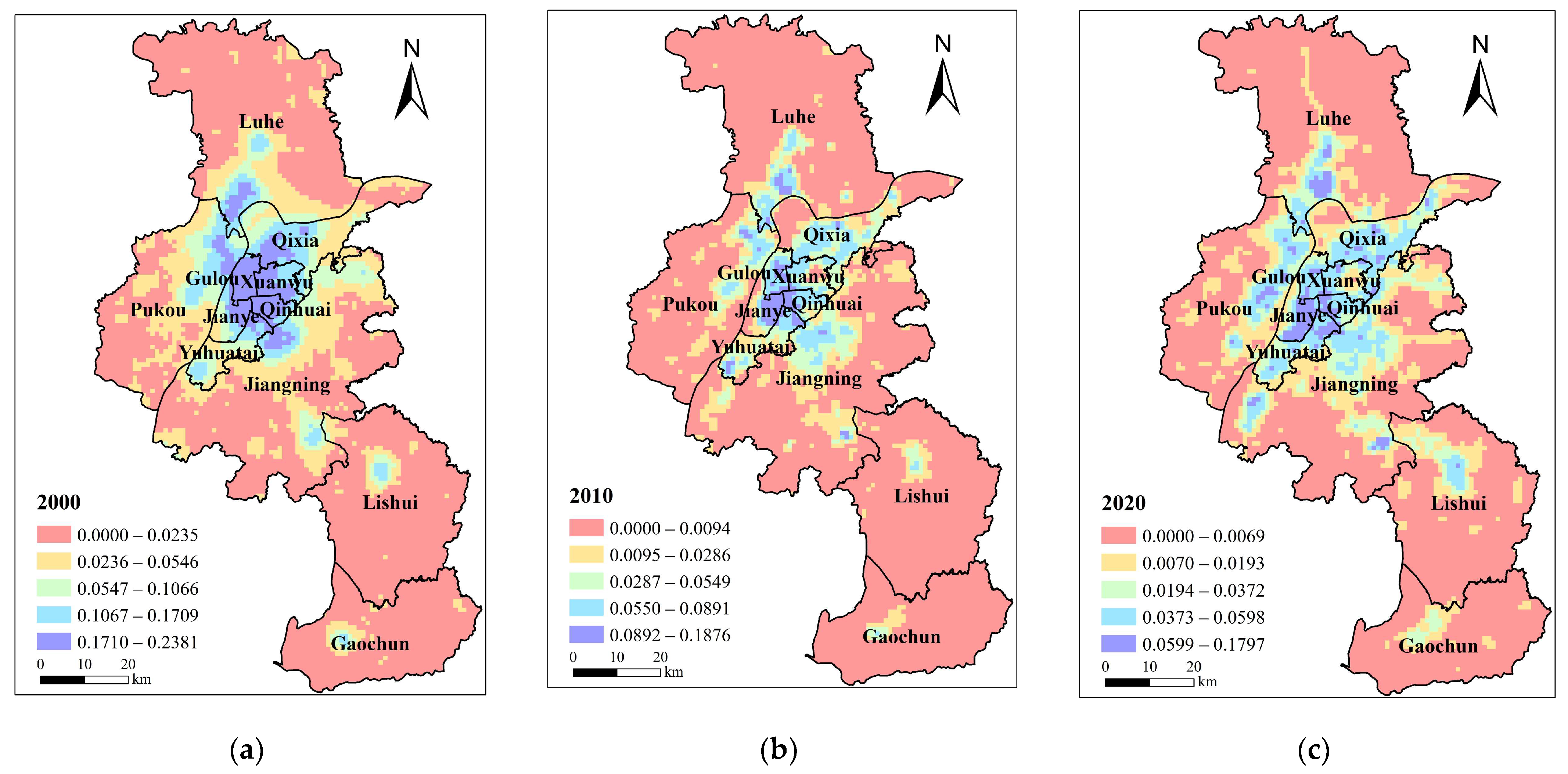
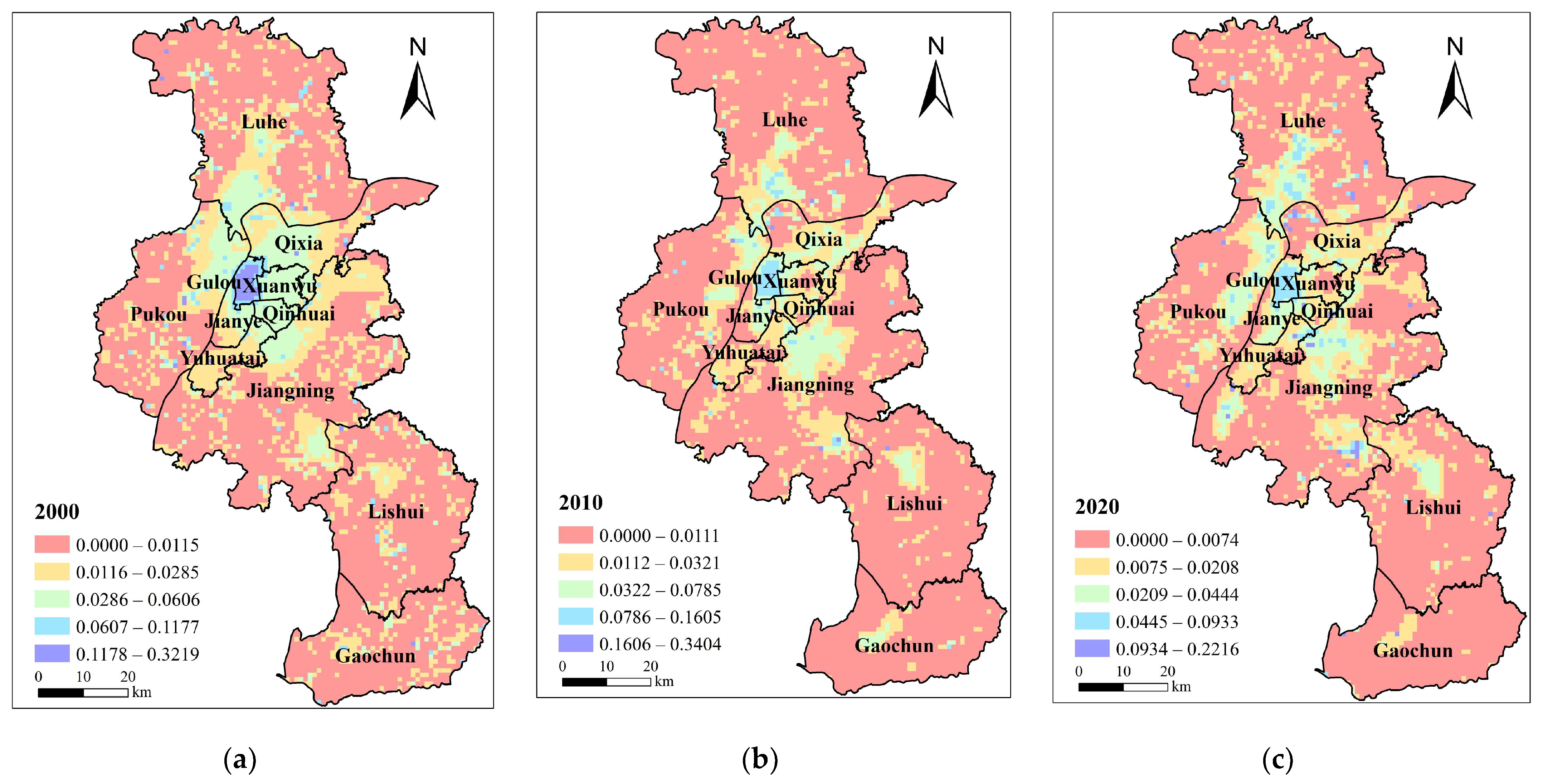
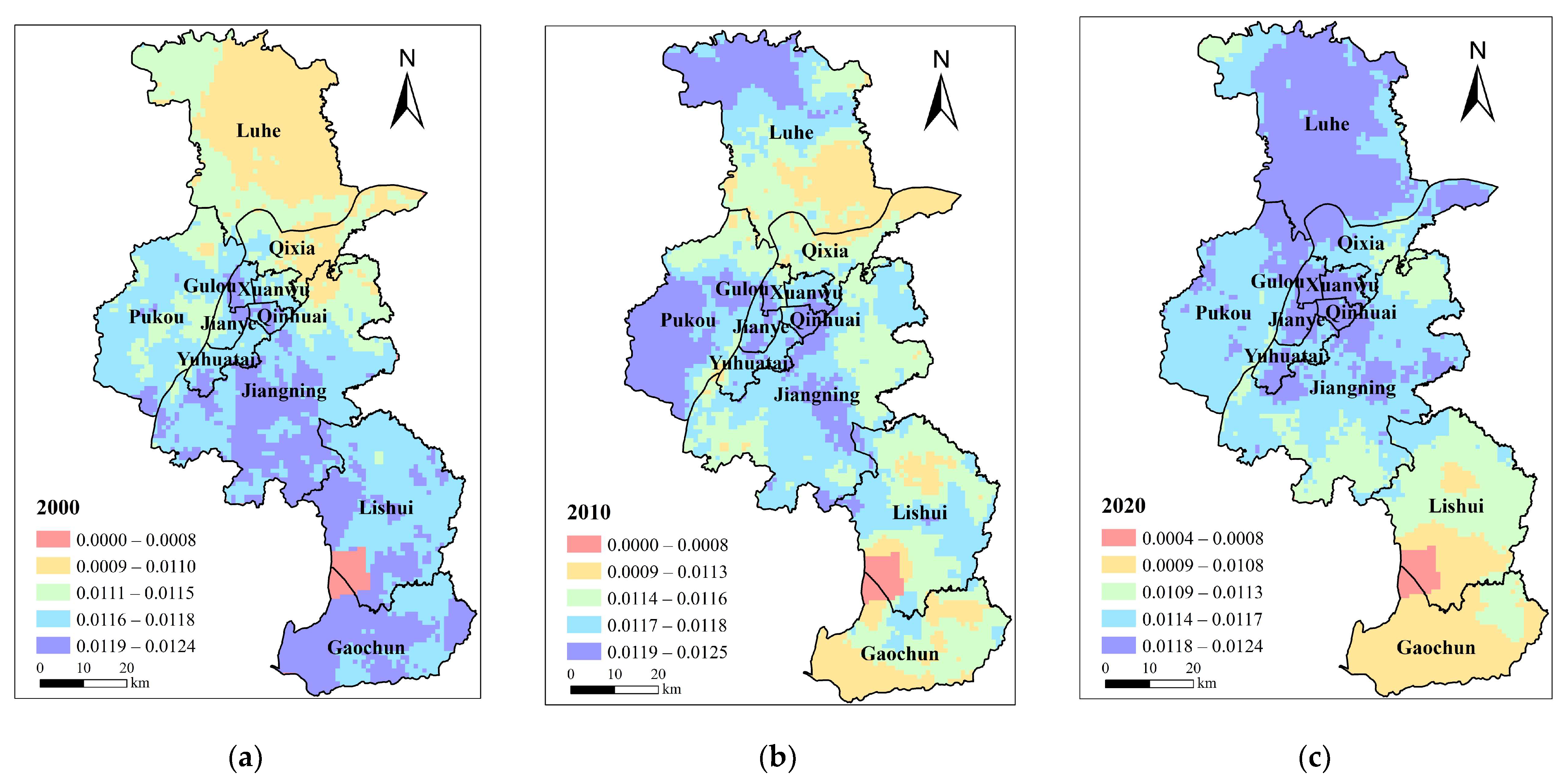
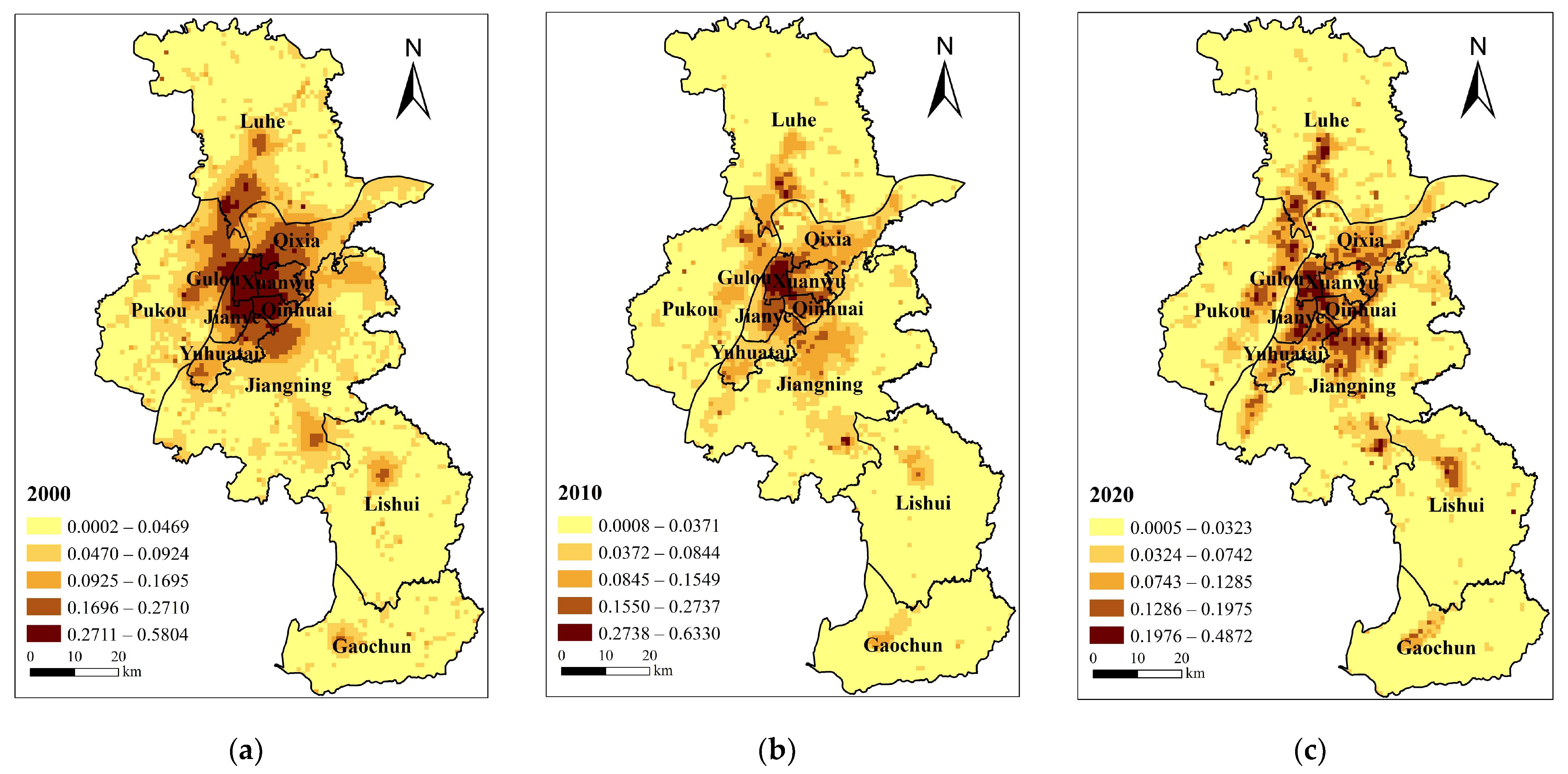
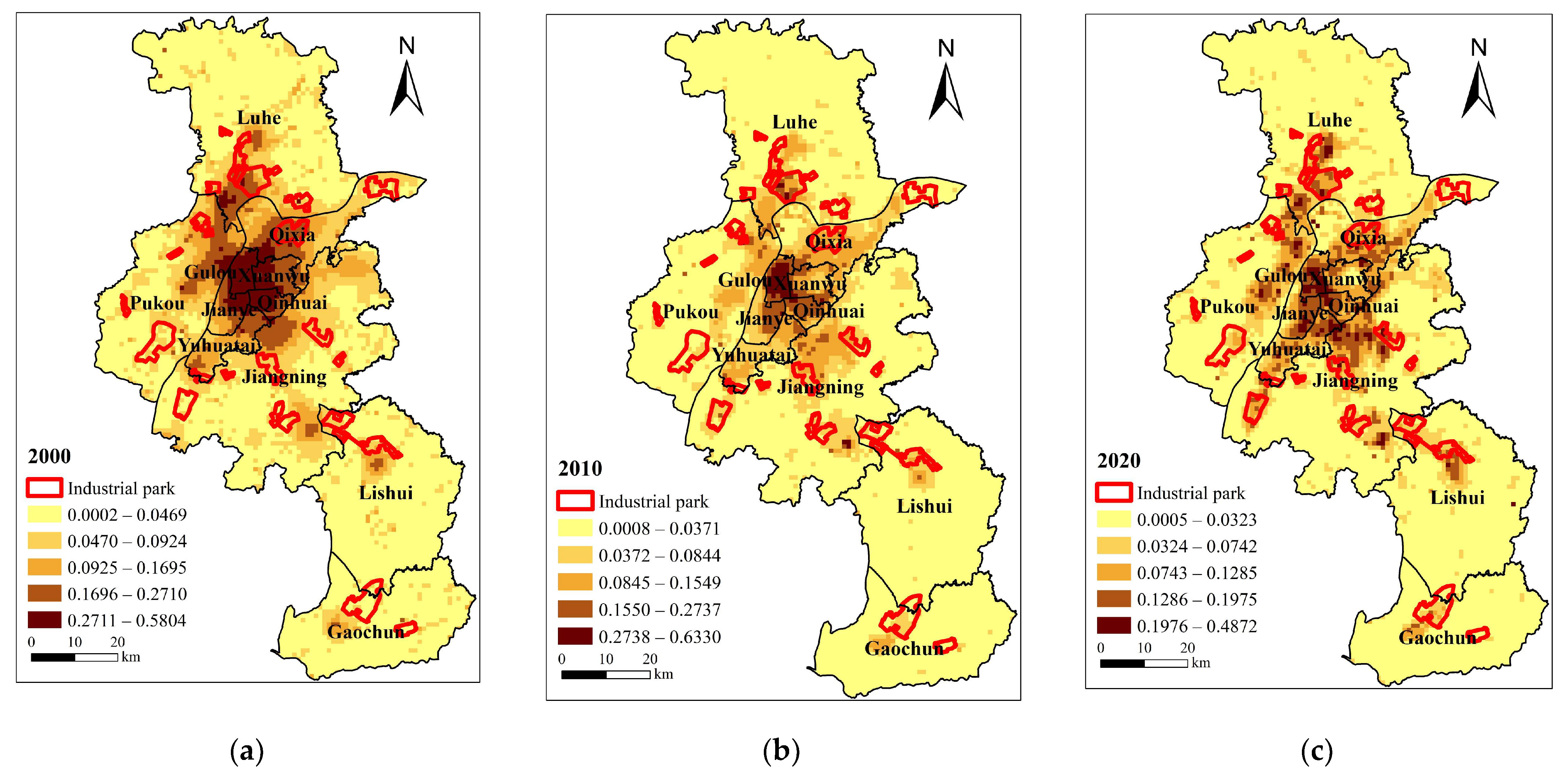
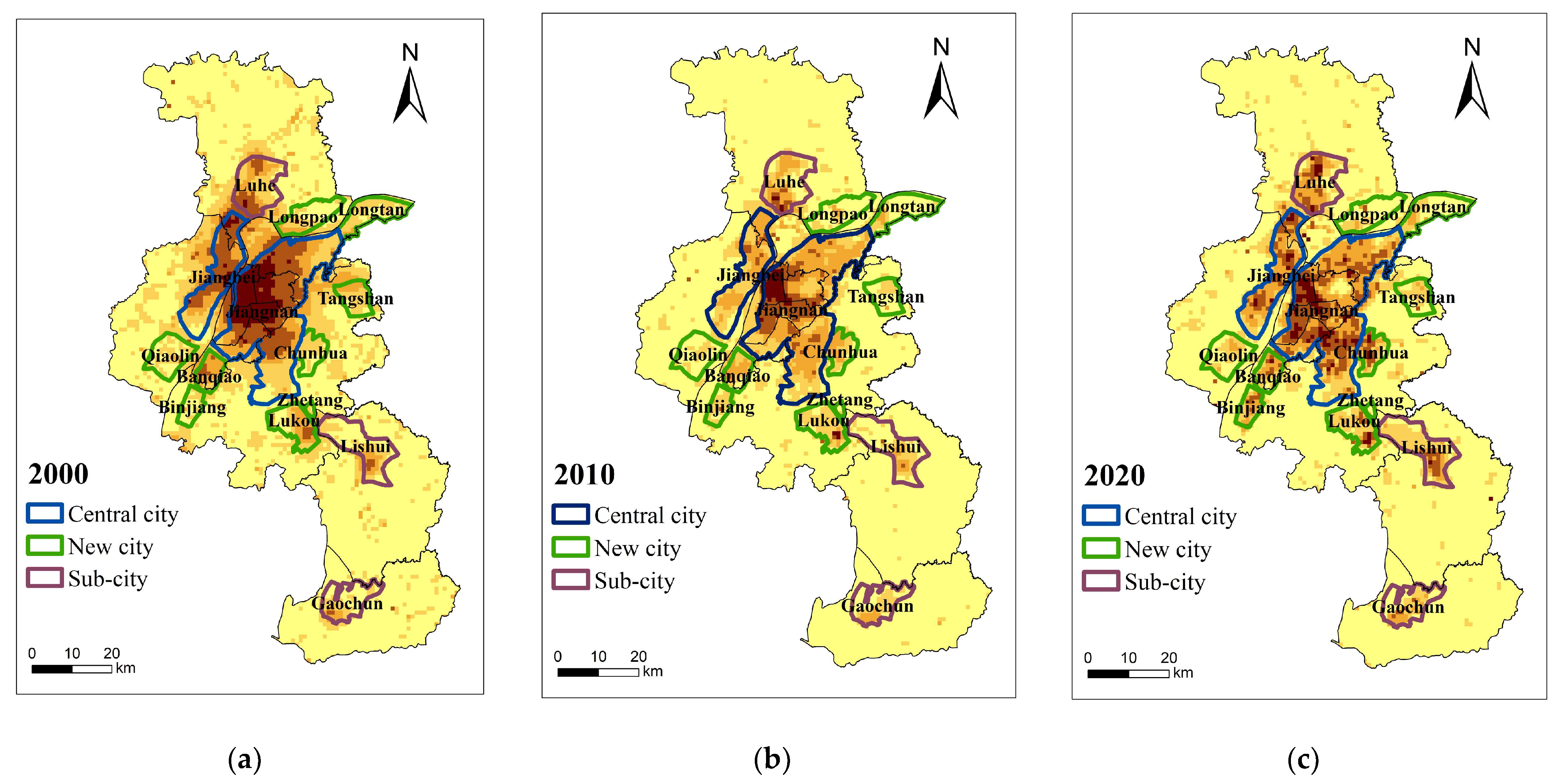
| Type | Carbon Emission Factor |
|---|---|
| Coal | 0.7329 |
| Oil | 0.5574 |
| Natural gas | 0.4226 |
| System | Indicators | Information Entropy Value (e) | Information Utility Value (d) | Weight Factor (w) |
|---|---|---|---|---|
| Society | Population density | 0.9412 | 0.0588 | 18.80% |
| Building density | 0.9541 | 0.0459 | 14.66% | |
| Economy | Night light | 0.9448 | 0.0552 | 17.65% |
| Intensity of land development | 0.9738 | 0.0262 | 8.37% | |
| Ecology | Carbon emissions | 0.9461 | 0.0539 | 17.24% |
| Fragmentation | 0.9311 | 0.0689 | 22.02% | |
| Environment | Surface temperature | 0.9997 | 0.0003 | 0.09% |
| PM2.5 | 0.9963 | 0.0037 | 1.17% |
| Factors | Variables | Instructions |
|---|---|---|
| / | Demand | The dependent variable |
| Level of economic development | GDP | Data are from the Resource and Environmental Science and Data Center (https://www.resdc.cn/, accessed on 28 March 2022). |
| Industrial | According to whether the plot is an industrial park site or not, the values of 1 and 0 are assigned, respectively. | |
| Urban spatial layout | Function | Plots are assigned values according to different classes of cities. |
| Decision management orientation | Newpark | Assign values of 1 and 0, respectively, according to whether there is an additional park on the plot. |
| Industrial | 0.0079817 | 0.0012813 | 6.23 | 0.000 | 0.051056 |
| GDP | 2.72 | 8.44 | 32.2 | 0.000 | 0.296364 |
| Function | 0.0208163 | 0.0003914 | 53.19 | 0.000 | 0.500803 |
| Newpark | 0.0158649 | 0.0011213 | 14.15 | 0.000 | 0.120005 |
| Constant | 0.0165263 | 0.0004359 | 37.91 | 0.000 | / |
| Administrative District | GDP/Billion CNY | Fixed Asset Investment/Billion CNY | ||||
|---|---|---|---|---|---|---|
| 2000 | 2010 | 2020 | 2000 | 2010 | 2020 | |
| Xuanwu | 12.01 | 372.82 | 1108.66 | 13.53 | 91.6 | 152.28 |
| Qinhuai | 20.73 | 466.32 | 1286.6 | 20.79 | 162.41 | 247.61 |
| Jianye | 8.32 | 237.96 | 1121.53 | 13.91 | 175.89 | 460.54 |
| Gulou | 15.47 | 608.88 | 1772.6 | 25.08 | 185.54 | 297.06 |
| Pukou | 38.86 | 369.1 | 1407.06 | 12.38 | 410 | 903.68 |
| Qixia | 15.52 | 681.11 | 1569.15 | 14.01 | 290.84 | 552.23 |
| Yuhuatai | 29.77 | 214.87 | 947.14 | 18.16 | 214.18 | 318.04 |
| Jiangning | 101.34 | 678.58 | 2509.32 | 36.66 | 630 | 807.8 |
| Luhe | 49.68 | 575.99 | 1654.88 | 14.69 | 455.04 | 627.69 |
| LiShui | 38.27 | 250.16 | 911.51 | 10.53 | 224.53 | 383.56 |
| Gaochun | 37.33 | 247.26 | 513.13 | 9.8 | 190.11 | 211.77 |
Disclaimer/Publisher’s Note: The statements, opinions and data contained in all publications are solely those of the individual author(s) and contributor(s) and not of MDPI and/or the editor(s). MDPI and/or the editor(s) disclaim responsibility for any injury to people or property resulting from any ideas, methods, instructions or products referred to in the content. |
© 2023 by the authors. Licensee MDPI, Basel, Switzerland. This article is an open access article distributed under the terms and conditions of the Creative Commons Attribution (CC BY) license (https://creativecommons.org/licenses/by/4.0/).
Share and Cite
Zhao, H.; Gu, B.; Fan, J.; Wang, J.; Luo, L. Socioeconomic Factors Influence the Spatial and Temporal Distribution of Blue–Green Infrastructure Demand: A Case of Nanjing City. Int. J. Environ. Res. Public Health 2023, 20, 3979. https://doi.org/10.3390/ijerph20053979
Zhao H, Gu B, Fan J, Wang J, Luo L. Socioeconomic Factors Influence the Spatial and Temporal Distribution of Blue–Green Infrastructure Demand: A Case of Nanjing City. International Journal of Environmental Research and Public Health. 2023; 20(5):3979. https://doi.org/10.3390/ijerph20053979
Chicago/Turabian StyleZhao, Haixia, Binjie Gu, Jinding Fan, Junqi Wang, and Liancong Luo. 2023. "Socioeconomic Factors Influence the Spatial and Temporal Distribution of Blue–Green Infrastructure Demand: A Case of Nanjing City" International Journal of Environmental Research and Public Health 20, no. 5: 3979. https://doi.org/10.3390/ijerph20053979





